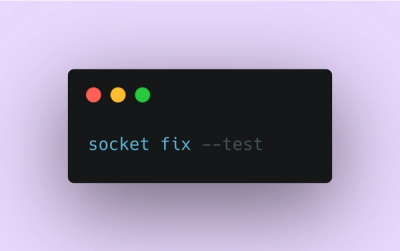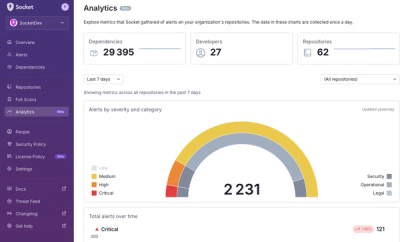
Product
Introducing Socket Fix for Safe, Automated Dependency Upgrades
Automatically fix and test dependency updates with socket fix—a new CLI tool that turns CVE alerts into safe, automated upgrades.
mongo-seeding
Advanced tools

The ultimate solution for populating your MongoDB database. Define the data in JavaScript or JSON files. Import collections and documents!
To install the app, run the following command:
npm install mongo-seeding --save
Import the Seeder class:
const { Seeder } = require('mongo-seeding');
Define a partial configuration object. The object will be merged with the default config object (see Configuration section). Therefore, you can specify only properties, which should override the default values, for example:
const config = {
database: {
host: '127.0.0.1',
port: 27017,
name: 'mydatabase',
},
dropDatabase: true,
};
Instead of database configuration object, you can also provide database connection URI to the database property:
const config = {
database: 'mongodb://127.0.0.1:27017/mydatabase',
dropDatabase: true,
};
Instantiate Seeder class:
const seeder = new Seeder(config);
(OPTIONAL) To read MongoDB collections from disk, firstly follow the tutorial in order to define documents and collections to import. Next, read them using readCollectionsFromPath method:
const path = require('path');
const collections = seeder.readCollectionsFromPath(
path.resolve('./your/path'),
);
Seed your database:
with async/await, for example:
try {
await seeder.import(collections);
} catch (err) {
// Handle errors
}
// Do whatever you want after successful import
with raw promises:
seeder
.import(collections)
.then(() => {
// Do whatever you want after successful import
})
.catch((err) => {
// Handle errors
});
See an import data example for a sample Node.js application utilizing the library.
The Seeder class contains the following methods.
constructor(partialConfig?)Constructs a new Seeder instance and loads configuration for data import.
Configuration
You can override any default configuration property by passing partial config object to the Seeder constructor. The object is merged with the default configuration object. To use all default settings, simply omit the constructor argument (new Seeder()).
The following snippet represents the type definition of Seeder config with all available properties:
/**
* Defines configuration for database seeding.
*/
export interface SeederConfig {
/**
* Database connection URI or configuration object.
*/
database: SeederDatabaseConfig;
/**
* Maximum time of waiting for successful MongoDB connection in milliseconds. Ignored when `mongoClientOptions` are passed.
*/
databaseReconnectTimeout: number;
/**
* Drops entire database before import.
*/
dropDatabase: boolean;
/**
* Drops collection before importing it.
*/
dropCollections: boolean;
/**
* Deletes all documents from every collection that is being imported.
*/
removeAllDocuments: boolean;
/**
* Optional MongoDB client options.
*/
mongoClientOptions?: MongoClientOptions;
/**
* Optional MongoDB collection write options.
*/
bulkWriteOptions?: BulkWriteOptions;
}
export interface SeederDatabaseConfigObject {
protocol: string;
host: string;
port: number;
name: string;
username?: string;
password?: string;
options?: SeederDatabaseConfigObjectOptions; // see all options for Database Connection URI: https://docs.mongodb.com/manual/reference/connection-string
}
export type SeederDatabaseConfigObjectOptions = {
[key: string]: string;
};
In order to configure database connection, specify connection URI for database property or assign a partial SeederDatabaseConfigObject object, overriding necessary properties.
Default configuration:
The default configuration object is as follows:
const defaultConfig = {
database: {
protocol: 'mongodb',
host: '127.0.0.1',
port: 27017,
name: 'database',
username: undefined,
password: undefined,
},
databaseReconnectTimeout: 10000,
dropDatabase: false,
dropCollections: false,
mongoClientOptions: undefined,
bulkWriteOptions: undefined,
};
readCollectionsFromPath(path, partialOptions?)Populates collections and their documents from given path. The path has to contain import data structure described here.
Options
You can specify an optional partial options object for this method, which will be merged with default configuration object. See the interface of the options, which describes all possible options:
/**
* Defines collection reading configuration.
*/
export interface SeederCollectionReadingOptions {
/**
* Files extensions that should be imported
*/
extensions: string[];
/**
* Options for parsing EJSON files with `.json` extension
*/
ejsonParseOptions?: EJSONOptions;
/**
* Optional transformer functions that can be used to modify collection data before import.
*/
transformers: ((collection: SeederCollection) => SeederCollection)[];
}
For example, you may provide the following options object:
const collectionReadingOptions = {
extensions: ['ts', 'js', 'cjs', 'json'],
ejsonParseOptions: {
relaxed: false,
},
transformers: [Seeder.Transformers.replaceDocumentIdWithUnderscoreId],
};
const collections = seeder.readCollectionsFromPath(
path.resolve('./your/path'),
collectionReadingOptions,
);
Transform function is a simple function in a form of (collection: SeederCollection) => SeederCollection. It means that you can manipulate collections after reading them from disk. SeederCollection is defined as follows:
interface SeederCollection {
name: string;
documents: object[];
}
There is two built-in transform functions:
Seeder.Transformers.replaceDocumentIdWithUnderscoreId, which replaces id field with _id property for every document in collection.
Seeder.Transformers.setTimestamps, which sets createdAt and updatedAt timestamps for every document in collection.
Default options
The default options object is as follows:
const defaultCollectionReadingConfig: SeederCollectionReadingConfig = {
extensions: ['json', 'js', 'cjs'],
ejsonParseOptions: {
relaxed: true,
},
transformers: [],
};
import(collections, partialConfig?)This method connects to a database and imports all provided collections. collections argument type is an array of SeederCollection type, which is defined as follows:
interface SeederCollection {
name: string;
documents: object[];
}
Configuration
You can provide additional partialConfig argument in a form of Seeder partial configuration object - the same used in the constructor. It is an easy way to change the configuration for one single data import. The configuration object will be merged with provided configuration from constructor and default config.
In order to see debug output, set environmental variable DEBUG to value mongo-seeding before starting your Node.js app:
DEBUG=mongo-seeding node yourapp/index.js
You can also set it programmatically before requiring mongo-seeding:
process.env.DEBUG = 'mongo-seeding';
const { Seeder } = require('mongo-seeding');
FAQs
The ultimate Node.js library for populating your MongoDB database.
The npm package mongo-seeding receives a total of 7,713 weekly downloads. As such, mongo-seeding popularity was classified as popular.
We found that mongo-seeding demonstrated a healthy version release cadence and project activity because the last version was released less than a year ago. It has 1 open source maintainer collaborating on the project.
Did you know?

Socket for GitHub automatically highlights issues in each pull request and monitors the health of all your open source dependencies. Discover the contents of your packages and block harmful activity before you install or update your dependencies.

Product
Automatically fix and test dependency updates with socket fix—a new CLI tool that turns CVE alerts into safe, automated upgrades.

Security News
CISA denies CVE funding issues amid backlash over a new CVE foundation formed by board members, raising concerns about transparency and program governance.

Product
We’re excited to announce a powerful new capability in Socket: historical data and enhanced analytics.